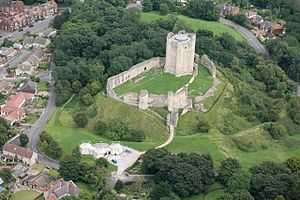Thomas de Ros, 9th Baron de Ros
| Thomas de Ros, 9th Baron de Ros | |
|---|---|
|
Arms of de Ros: Gules, three water bougets argent[1] | |
| Spouse(s) | Philippe Tiptoft |
|
Issue | |
| Father | Thomas de Ros, 8th Baron de Ros |
| Mother | Eleanor Beauchamp |
| Born |
9 September 1427 Conisbrough Castle, Yorkshire |
| Died | 17 May 1464 (aged 36) |
| Buried | Hexham, Northumberland |
Thomas de Ros or Roos, 9th Baron de Ros of Helmsley (9 September 1427 – 17 May 1464) was a follower of the House of Lancaster during the Wars of the Roses.
Family

Thomas de Ros, born 9 September 1427, was the eldest son of Thomas de Ros, 8th Baron de Ros and Eleanor Beauchamp, second daughter of Richard de Beauchamp, 13th Earl of Warwick, and his first wife, Elizabeth Berkeley, daughter and heiress of Thomas de Berkeley, 5th Baron Berkeley.[2] Eleanor was an older half-sister of Henry de Beauchamp, 1st Duke of Warwick, and Anne Neville, Countess of Warwick.
Thomas himself was an older maternal half-brother to Henry Beaufort, 3rd Duke of Somerset, and Edmund Beaufort, 4th Duke of Somerset.
Career
In February 1461, he had been one of the knights made at the second Battle of St Albans by Edward of Westminster, Prince of Wales. Thomas had inherited the barony of de Ros when he was barely four years old. His great uncle, Sir Robert Ros, knight, was deputed to perform the office of chamberlain to Archbishop Stafford, on the day of his installation at Canterbury; this office belonged to the Lord Ros, from his tenure of the manor of Hethfield, in Kent. The fee for this service was the furniture of the room, and the basin and towel. The manor, and tenure on which it was held, came to the Ros family, from the marriage of an ancestor with Margaret Badlesmere.
Thomas Lord Ros was only eighteen years of age when put by the king into full possession of his father's estates. Having been faithful to Henry VI throughout his reign, he was rewarded with certain commercial privileges, consisting, chiefly, in an entire remission of the customary duties on exported wool. In 1456, he had permission to go on a pilgrimage, and in 1460, the king settled on him, as in part, a recompense for the expenses and losses incurred in his service, an annuity of £40, arising out of certain manors forfeited by the Earl of Salisbury. In the same year, being with the king at York when news arrived of the Lancastrian defeat at the Battle of Towton, he accompanied Henry to Berwick.
As a loyal supporter of King Henry VI of England, de Ros was attainted in Parliament on 4 November 1461. He led a section of the Lacastrian army which attacked John Neville's army at the Battle of Hedgeley Moor on 25 April, where his men fled, and then took part in the Battle of Hexham on 15 May 1464. The Lancastrian army was crushed by Neville; Roos was subsequently found hiding with lord Hungerford in a wood. He was beheaded he next day at Newcastle for treason,[3] and the Ros lands were confiscated. Belvoir Castle was given to William, Lord Hastings.
Marriage and children
Thomas de Ros married Philippa Tiptoft, daughter of John Tiptoft, 1st Baron Tiptoft, by whom he had one son and four daughters:[4]
- Edmund de Ros, 10th Baron de Ros.
- Eleanor de Ros, who married Sir Robert Manners of Etal, Northumberland.
- Isabel de Ros, who married firstly Sir Thomas Everingham, secondly Sir Thomas Grey, and thirdly Sir Thomas Lovell.
- Margaret de Ros
- Joan de Ros.
Footnotes
- ↑ Debrett's Peerage, 1968, p.347
- ↑ Cokayne 1949, p. 105; Richardson III 2011, p. 459.
- ↑ Gillingham, J., The Wars of the Roses, London (repr.) 193, pp. 151-2
- ↑ Cokayne 1949, p. 106; Richardson III 2011, p. 459.
References
- Cokayne, George Edward (1949). The Complete Peerage, edited by Geoffrey H. White XI. London: St. Catherine Press.
- Richardson, Douglas (2011). Magna Carta Ancestry: A Study in Colonial and Medieval Families, ed. Kimball G. Everingham III (2nd ed.). Salt Lake City. ISBN 144996639X
Ancestry
| Ancestors of Thomas de Ros, 9th Baron de Ros | ||||||||||||||||||||||||||||||||||||||||||||||||||||||||||||||||||||||||||||||||||||||||||||||||||||||||||||||||||||||||||||||||||||||||||||||||||||||||||||||||||||||||||||||||||||||||||||||||||||||||||||||||||||||||||||||||||||||||||||||||||||||||||||||||||||||||||||||||||||||||||||||||||||||||||||||||||||||||||||||||||||||||||||||||||||||||||||||||||||||||||||||||||||||||||||||||||||||||||||||||||||||||||||||||||||||||||||||||||||||||||||||||||||||||||||||||||||||||||||||||||||||||||||||||||||||||||||||||||
|---|---|---|---|---|---|---|---|---|---|---|---|---|---|---|---|---|---|---|---|---|---|---|---|---|---|---|---|---|---|---|---|---|---|---|---|---|---|---|---|---|---|---|---|---|---|---|---|---|---|---|---|---|---|---|---|---|---|---|---|---|---|---|---|---|---|---|---|---|---|---|---|---|---|---|---|---|---|---|---|---|---|---|---|---|---|---|---|---|---|---|---|---|---|---|---|---|---|---|---|---|---|---|---|---|---|---|---|---|---|---|---|---|---|---|---|---|---|---|---|---|---|---|---|---|---|---|---|---|---|---|---|---|---|---|---|---|---|---|---|---|---|---|---|---|---|---|---|---|---|---|---|---|---|---|---|---|---|---|---|---|---|---|---|---|---|---|---|---|---|---|---|---|---|---|---|---|---|---|---|---|---|---|---|---|---|---|---|---|---|---|---|---|---|---|---|---|---|---|---|---|---|---|---|---|---|---|---|---|---|---|---|---|---|---|---|---|---|---|---|---|---|---|---|---|---|---|---|---|---|---|---|---|---|---|---|---|---|---|---|---|---|---|---|---|---|---|---|---|---|---|---|---|---|---|---|---|---|---|---|---|---|---|---|---|---|---|---|---|---|---|---|---|---|---|---|---|---|---|---|---|---|---|---|---|---|---|---|---|---|---|---|---|---|---|---|---|---|---|---|---|---|---|---|---|---|---|---|---|---|---|---|---|---|---|---|---|---|---|---|---|---|---|---|---|---|---|---|---|---|---|---|---|---|---|---|---|---|---|---|---|---|---|---|---|---|---|---|---|---|---|---|---|---|---|---|---|---|---|---|---|---|---|---|---|---|---|---|---|---|---|---|---|---|---|---|---|---|---|---|---|---|---|---|---|---|---|---|---|---|---|---|---|---|---|---|---|---|---|---|---|---|---|---|---|---|---|---|---|---|---|---|---|---|---|---|---|---|---|---|---|---|---|---|---|---|---|---|---|---|---|---|---|---|---|---|---|---|---|---|---|---|---|---|---|---|---|---|---|---|---|---|---|---|---|---|---|---|---|---|---|---|---|---|---|---|---|---|---|---|---|---|---|---|---|---|---|---|---|---|---|---|---|---|---|---|---|---|---|---|---|---|---|---|---|---|---|---|---|---|---|---|---|---|---|---|---|---|---|---|---|---|---|---|---|
| ||||||||||||||||||||||||||||||||||||||||||||||||||||||||||||||||||||||||||||||||||||||||||||||||||||||||||||||||||||||||||||||||||||||||||||||||||||||||||||||||||||||||||||||||||||||||||||||||||||||||||||||||||||||||||||||||||||||||||||||||||||||||||||||||||||||||||||||||||||||||||||||||||||||||||||||||||||||||||||||||||||||||||||||||||||||||||||||||||||||||||||||||||||||||||||||||||||||||||||||||||||||||||||||||||||||||||||||||||||||||||||||||||||||||||||||||||||||||||||||||||||||||||||||||||||||||||||||||||
| Peerage of England | ||
|---|---|---|
| Preceded by Thomas de Ros |
Baron de Ros 1430–1464 |
Succeeded by Edmund de Ros |
.svg.png)